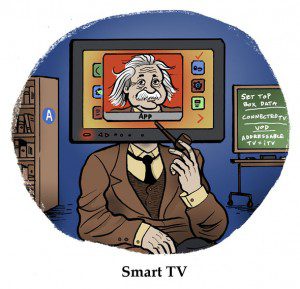TV broadcasters are blaming the economy for the less-than-stellar state of their end-of-year finances.
But smart TV manufacturers are fighting a pair of macroeconomic demons: slower ad spend and supply-chain shortages.
Vizio, which earns revenue from device sales and ad sales, finished Q4 with 30% more revenue YOY coming from its platform business, which includes content distribution in addition to advertising. Average revenue per user (ARPU) was also up 31% YOY.
Not too shabby. But those numbers represent less than half the growth rates Vizio reported in Q4 of 2021 for its platform business (up 74% YOY) and ARPU (up 67% YOY). And revenue from device sales was down 24% over the same time horizon.
“Growth in advertising spend started out strong in 2022,” CEO William Wang told shareholders on Tuesday, “but a tougher ad market closed out the year.”
Vizio is banking on its ads business – and the viewing data behind it – to help turn things around.
All about advertising
Step one to attracting more ad demand is increasing viewership.
Vizio spent Q4 launching new apps for both streaming services and linear networks, including AMC+, Fox Sports and Discovery GO. As a result, Vizio drew in 15% more active accounts compared to last year, and viewing time was up 24%.
These investments put Vizio in a better position to support advertisers with more scale, Wang said.
The effort seems to be paying off. Vizio inked partnerships with 130 advertisers in Q4 (53% more than last year), and recently closed $200 million in upfront commitments through direct deals with agencies.
Advertising revenue was up 25% last quarter, compared with 17% the year before.
Most of the growth Vizio is seeing from its platform business is thanks to advertising, said CFO Adam Townsend, and fueling that growth is Vizio’s automatic content recognition (ACR) data, which underpins its ad sales business.
ACR-you there?
Vizio apparently won an EMMY award last month for how it uses smart TV data for ad targeting and personalized content recommendations. (Really.)
But Vizio needs ad dollars more than it needs awards, which is why using ACR to woo buyers is a priority. ACR tracks what titles viewers are watching and when, giving marketers a more concrete sense of where to reach their audiences.
The number of brands spending through Vizio’s managed service offering – which is where buyers can access its ACR targeting and analytics suite – grew by 37% in the past year.
Vizio doesn’t keep its ACR data in a walled garden, though. Data licensing contributed the biggest boost to the company’s nonadvertising revenue, Townsend said.
“Our currency-grade viewership is highly valuable in the ad marketplace,” he said. “Measurement companies, networks and agencies [all] rely on it.”
TV’s new turf war
But although ACR is helping Vizio’s bottom line, device sales are tanking, and Vizio now has new competition, including Roku, to contend with.
“We expect the TV market to remain highly competitive,” Townsend said, so boosting device sales is at the top of Vizio’s to-do list this year. Without TVs in households, Vizio has no ad sales business.
According to Wang, Vizio’s plan is to sell more TVs by making its program guides more personalized and easier to navigate.
In the meantime, Vizio doesn’t seem too concerned about the new competition in town. Roku is working on releasing its first-ever smart TVs and, like Vizio, is betting on personalization and ACR as revenue drivers.
But Vizio has been building and monetizing TV sets for 20 years, Wang said, and new device makers will have “a lot to learn” over the next few years to build competitive expertise.
And Vizio remains “cautiously optimistic” about a Q1 “rebound” in overall revenue growth, Townsend said.
Still, shares dipped 5% in after-hours trading on Tuesday.














